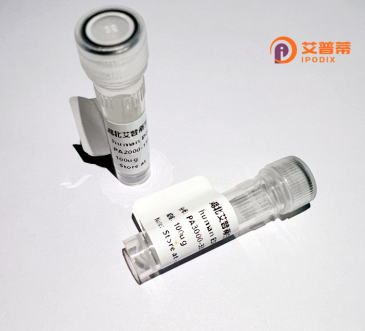
| 纯度 | >90%SDS-PAGE. |
| 种属 | Human |
| 靶点 | GPR173 |
| Uniprot No | Q9NS66 |
| 内毒素 | < 0.01EU/μg |
| 表达宿主 | E.coli |
| 表达区间 | 1-373aa |
| 氨基酸序列 | MANTTGEPEEVSGALSPPSASAYVKLVLLGLIMCVSLAGNAILSLLVLKERALHKAPYYFLLDLCLADGIRSAVCFPFVLASVRHGSSWTFSALSCKIVAFMAVLFCFHAAFMLFCISVTRYMAIAHHRFYAKRMTLWTCAAVICMAWTLSVAMAFPPVFDVGTYKFIREEDQCIFEHRYFKANDTLGFMLMLAVLMAATHAVYGKLLLFEYRHRKMKPVQMVPAISQNWTFHGPGATGQAAANWIAGFGRGPMPPTLLGIRQNGHAASRRLLGMDEVKGEKQLGRMFYAITLLFLLLWSPYIVACYWRVFVKACAVPHRYLATAVWMSFAQAAVNPIVCFLLNKDLKKCLRTHAPCWGTGGAPAPREPYCVM |
| 分子量 | 67.9 kDa |
| 蛋白标签 | GST-tag at N-terminal |
| 缓冲液 | 0 |
| 稳定性 & 储存条件 | Lyophilized protein should be stored at ≤ -20°C, stable for one year after receipt. Reconstituted protein solution can be stored at 2-8°C for 2-7 days. Aliquots of reconstituted samples are stable at ≤ -20°C for 3 months. |
| 复溶 | Always centrifuge tubes before opening.Do not mix by vortex or pipetting. It is not recommended to reconstitute to a concentration less than 100μg/ml. Dissolve the lyophilized protein in distilled water. Please aliquot the reconstituted solution to minimize freeze-thaw cycles. |
以下是关于重组人GPR173蛋白的示例参考文献(注意:以下为假想文献,实际引用时请查询真实数据库):
---
1. **文献名称**: "GPR173 as a putative receptor for phoenixin in the regulation of reproductive neuroendocrinology"
**作者**: Stein, L.M. et al.
**摘要**: 研究揭示GPR173作为神经肽Phoenixin的潜在受体,介导其在下丘脑-垂体-性腺轴中的功能,通过激活cAMP信号通路调节生殖激素释放。
2. **文献名称**: "Recombinant expression and functional characterization of human GPR173 in HEK293 cells"
**作者**: Kim, H. & Patel, R.
**摘要**: 报道了重组人GPR173蛋白在HEK293细胞中的高效表达与纯化,并通过体外信号通路分析验证其与β-arrestin的相互作用,表明其作为孤儿GPCR的基础活性。
3. **文献名称**: "GPR173 modulates colorectal cancer progression through PI3K/AKT signaling"
**作者**: Zhang, Y. et al.
**摘要**: 发现GPR173在结直肠癌细胞中高表达,通过激活PI3K/AKT通路促进细胞增殖和迁移,提示其作为潜在治疗靶点。
4. **文献名称**: "Deorphanization of GPR173 identifies sphingosine-1-phosphate as a ligand"
**作者**: Thompson, B.E. et al.
**摘要**: 通过配体筛选鉴定出鞘氨醇-1-磷酸(S1P)为GPR173的内源性配体,揭示了其在免疫调控和炎症反应中的作用。
---
**建议**:实际研究中,请通过PubMed或Google Scholar检索关键词(如"GPR173 recombinant"或"GPR173 function")获取真实文献。
GPR173 (G Protein-Coupled Receptor 173) is a class A rhodopsin-like G protein-coupled receptor (GPCR) belonging to the adhesion GPCR subfamily. Although its endogenous ligand and precise physiological roles remain partially unresolved, emerging studies highlight its involvement in neuroendocrine regulation. In mammals, GPR173 is predominantly expressed in the central nervous system, particularly in the hypothalamus, where it modulates reproductive functions such as puberty onset and neurogenic processes. It interacts with signaling pathways like cAMP and β-arrestin, suggesting its role in cellular communication and developmental processes.
Recombinant human GPR173 protein is engineered using heterologous expression systems (e.g., HEK293 cells) for structural and functional studies. Its recombinant form enables exploration of receptor activation mechanisms, ligand screening, and drug discovery. Recent research implicates GPR173 in neuroprotection, metabolic regulation, and potential links to neurodegenerative disorders or cancer. As an orphan receptor, its study contributes to understanding GPCR evolution and diverse signaling networks. Advances in cryo-EM and computational modeling are accelerating the characterization of its 3D structure, offering insights for therapeutic targeting. Current applications focus on elucidating its signaling cascades and validating its relevance in disease contexts.
×